Introduction
Not of works, lest any man should boast.
For we are his workmanship, created in Christ Jesus unto good works,
which God hath before ordained that we should walk in them."
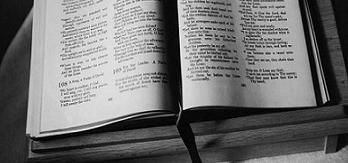
My sons, I don't know when your first Tefft ancestor was born, or where. But I do believe that for a thousand years and probably longer, God has created and prepared us, the Teffts, to do the good works that Jesus Christ wants us to do today and into the future. We should give God all the credit for what He has done and for what He will continue to do in our lives and the lives of those who come after us. My belief is that genealogy, the study of one's own family history, for any other purpose than to glorify God, is in itself a form of boasting and we shouldn't do it. Not unlike the concept of royalty, we could claim that somehow through genetics we have passed on our best family traits from one generation to the next. But family lines cannot be charted as an upward slope on a graph, with people getting better, stronger or wiser as time marches on. In fact, I think we humans may be experiencing a decline in the gifts and capabilities that God originally gave our species.
Plutarch, a Greek philosopher in the first century said "It is indeed a desirable thing to be well-descended, but the glory belongs to our ancestors." I would like to remake the last phrase to "but the glory belongs to God through our ancestors".
The story of the Tefft family that follows illustrates how God has always had a specific purpose for each one of us in generational succession. By reading this story I hope you'll also realize that we're not here today because of some great deeds we or our ancestors have done in the past. We're here only by the infinite grace of God. God asks for nothing in return for His gift of life, but since we are His product we should always try to order our lives after the example of His presence among us, Jesus Christ. We can trust God to fulfill his plan through us when we're alive on this earth, and He has promised to continue to bless us with life everlasting once we've gone. So boys, have faith in God and keep it strong!
The Tefft Name
A late 19th century letter from one Tefft family member to another spoke of the possibility that the Tefft name originally came from the French
Huguenot name "Thevet".
We don't really know with any degree of certainty that there's any family connection between the Thevets of France and the Teffts in America (and it may be
fanciful conjecture), but it is rather fun to imagine that a Thevet family member, perhaps a relative of the famous South American explorer Andre Thevet
(pictured here), was driven out of France because of terrible religious turmoil during the 1500's. We could further speculate that he may have made his
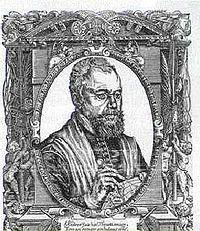 way to England, where his family changed its name to "Teffe", or "Tefft" to avoid scrutiny, misunderstanding, and potential religious persecution in their
new homeland. Based on my instincts regarding the Tefft family and some of their predominant personality traits, it could have happened this way. The Tefft
family later proved that they could easily assimilate and routinely become part of a new, strange and difficult environment.
way to England, where his family changed its name to "Teffe", or "Tefft" to avoid scrutiny, misunderstanding, and potential religious persecution in their
new homeland. Based on my instincts regarding the Tefft family and some of their predominant personality traits, it could have happened this way. The Tefft
family later proved that they could easily assimilate and routinely become part of a new, strange and difficult environment.
John Tefft, the oldest known person in your direct ancestral line, was definitely born in England, probably about 1614. Unfortunately, we don't know
the first names of his father and mother, and no records have been found that offer any specific details about the Teffts before this time. But we can examine
the next four hundred years of events which led the Tefft family from where we were then to where we are now.
"The Tefft Ancestry", a collection of Tefft names and notable events written by Rev. Charles H.W. Stocking in 1904 summarizes the Tefft family this way:
"It will be observed by the reader of the following pages that the Teffts were an intensely patriotic family, their names frequently appearing on the
rosters of regiments in the Colonial, Revolutionary, and 1812 wars. They were equally prominent in civil affairs, holding both local and State offices,
sometimes for very many years. In religious faith they were generally Baptists, the prevailing sect in Rhode Island, a faith to which many of their
descendants are loyal to the present time."
England 1575-1620
In the few decades preceding John Tefft's 1614 birth in England, Elizabeth had reigned as Queen of England. Queen Elizabeth had been raised
from childhood in the Protestant faith. But Pope Paul IV was unhappy that a Protestant monarch was in power in England, so he excommunicated
Elizabeth from the Catholic Church, and ordered her subjects not to obey her. Elizabeth nevertheless set about making England a Protestant
nation. Catholic bishops were replaced by Protestant bishops, and Parliament passed the famous "Act of Uniformity". After that,
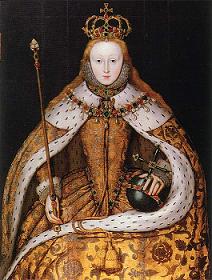 all people in England were required to attend Protestant church services by law.
all people in England were required to attend Protestant church services by law.
If the Tefft family originated as French Huguenots - or even if they didn't - at this point they were most certainly Protestants by faith.
These years in the late 1500's were also marked by many serious epidemics and plagues that swept across the English countryside, killing thousands at a
time. A particularly horrid epidemic struck in 1597 due to several years of heavy summer rains that had destroyed the local harvests. Food became
increasingly scarce, and poorer people who could no longer afford basic food needs became malnourished and prone to these infectious and deadly diseases.
This desperate situation led to riots in many of the large towns and protests in smaller ones.
William Shakespeare (1564-1616), the famous playwright and poet, lived in England during this extremely tense period, only about 140 miles away from
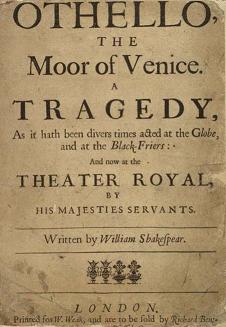 John Tefft's parents' home. Throughout his childhood and before he became prosperous, Shakespeare's life would have been very much like the Tefft's - a
struggle for food and a constant vigilance against disease epidemics. His daughter died from one of these plagues when she was only 11 years old.
Shakespeare wrote Hamlet in 1600, and Othello first appeared in 1603.
John Tefft's parents' home. Throughout his childhood and before he became prosperous, Shakespeare's life would have been very much like the Tefft's - a
struggle for food and a constant vigilance against disease epidemics. His daughter died from one of these plagues when she was only 11 years old.
Shakespeare wrote Hamlet in 1600, and Othello first appeared in 1603.
When Queen Elizabeth died in 1603, the English throne was passed to King James VI of Scotland, who had already been king of Scotland for 36 years. He was
from then on known as King James I of England. In great achievement, King James united Scotland, England and Ireland into what he referred to as "Great
Britain". But his crowning jewel was the commission of what is probably the most important book ever written - the Authorized King James Version of the
Bible. This new translation of the Bible was produced by the very best scholars and translators of the world, and all the writers had pursued God's Word
as the passion of their lives. By reading the translator's notes in the preface of this miraculously finished work, it becomes clear that the Catholic
Church opposed the idea of translating the Bible into the common language. To quote the translators, "So much are they afraid of the light of the scripture,
that they will not trust the people with it."
For many centuries, the English language had been just the vulgar language of everyday people while Latin was the language of the intellectually elite.
Shakespeare's writings and the King James Version of the Bible were instrumental in the development and proliferation of the English language as we know it
today. Men and women began to learn to read, using the King James Version as their guide. The words of the King James Version shaped their religion,
beliefs, and daily language. In our present day and age, the King James Bible continues to bring countless people to a life-saving knowledge of Jesus
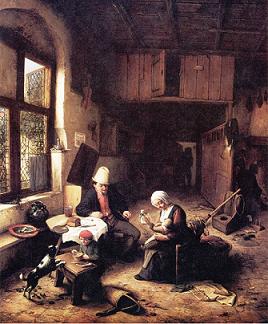 Christ. In 1607, under this same King James, the Virginia Company of England sent a group of colonists to "the place where America began", a settlement
that became known as Jamestowne. King James himself later wrote and authorized the Evangelistic Grant Charter to settle the whole Colony of Virginia. He
said its purpose was "to make habitation and to deduce a colony of sundry of our people into that part of America, commonly called Virginia in propagating
of Christian religion to such people as yet live in darkness to bring a settled and quiet government."
Infant mortality in all of England during this period was very high, and the lack of personal hygiene and contaminated drinking water often led to fatal disease
epidemics such as smallpox, scarlet fever, and typhus.
Christ. In 1607, under this same King James, the Virginia Company of England sent a group of colonists to "the place where America began", a settlement
that became known as Jamestowne. King James himself later wrote and authorized the Evangelistic Grant Charter to settle the whole Colony of Virginia. He
said its purpose was "to make habitation and to deduce a colony of sundry of our people into that part of America, commonly called Virginia in propagating
of Christian religion to such people as yet live in darkness to bring a settled and quiet government."
Infant mortality in all of England during this period was very high, and the lack of personal hygiene and contaminated drinking water often led to fatal disease
epidemics such as smallpox, scarlet fever, and typhus.
John Tefft (b. 1614) had an older brother, William, and perhaps as many as six other siblings. Their family home was likely a cottage similar to the
one shown on this page, and was probably near Appleby, Lincolnshire County, England. Domestic life for the Teffts would have been very
difficult during these times. In the English counties and parishes of that period there were no schools, shops or stores. There
was no running water, and clothes would have been worn for long periods without washing. There was no after-dark lighting inside the home
(gas lamps were much later) and little heat during the winter. Water was fetched and carried from rivers or streams in warm weather and
cold, and food was scarce save for garden vegetables, wild berries and perhaps an occasional fish caught in the local stream.
The Tefft family's existence and survival was dependent on their ability to take care of themselves and to feed themselves from the English
countryside. Certainly God was already preparing the child John Tefft for the adult life he will lead in the great American wilderness
within just a few short years.
England 1620-1630
 In 1620, when John Tefft was just about 6 years old, a group of "Separatists" set sail for America on a ship named the Mayflower. The
Separatists were Christians that wanted to completely separate from the Church of England, because they felt it was sinful to practice
the rituals and ceremonies that the Church of England demanded. Some of these Separatists had temporarily and surreptitiously moved to
Holland some years earlier, and under the leadership of William Bradford, they now embarked to Plymouth Plantation on the shores of Massachusetts,
which after Jamestowne, was the second successful English settlement in the new world.
In 1620, when John Tefft was just about 6 years old, a group of "Separatists" set sail for America on a ship named the Mayflower. The
Separatists were Christians that wanted to completely separate from the Church of England, because they felt it was sinful to practice
the rituals and ceremonies that the Church of England demanded. Some of these Separatists had temporarily and surreptitiously moved to
Holland some years earlier, and under the leadership of William Bradford, they now embarked to Plymouth Plantation on the shores of Massachusetts,
which after Jamestowne, was the second successful English settlement in the new world.
When King James died in 1625 the united royal crown of England, Scotland and Ireland was smoothly transitioned to King James' oldest living son,
King Charles I (pictured here). While the population had generally been fond of King James, especially in his later years, many developed an early fear
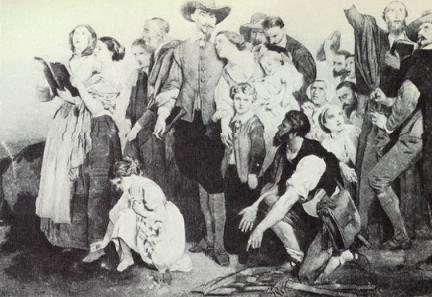 that his son Charles would become a tyrant. Abetting this distrust, especially among another devout religious group and political party called the Puritans,
was the new King's open support of Richard Montagu, an influential writer of the time who had already written a pamphlet in 1626 arguing against the
teachings of Protestant writer and teacher John Calvin.
that his son Charles would become a tyrant. Abetting this distrust, especially among another devout religious group and political party called the Puritans,
was the new King's open support of Richard Montagu, an influential writer of the time who had already written a pamphlet in 1626 arguing against the
teachings of Protestant writer and teacher John Calvin.
In 1628, King Charles granted a charter to several Puritan gentlemen, who had already purchased a track of land also on the Massachusetts Bay, a plantation they
called Salem, meaning "Peace." The King's charter authorized these gentlemen to establish and enforce laws for the settlers, who began to trickle in.
The North American settlement movement gained momentum in England as more and more Puritans and Separatists began to believe that reform of
the Church of England was impossible under King Charles.
The Tefft family in England would have heard about the new world from their neighbors and friends, and they must have been excited about the hope the
new continent seemed to offer!
John Tefft to America 1633
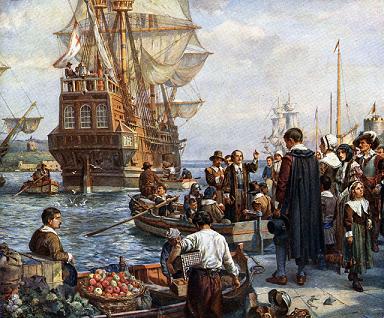 Under difficult economic, social and religious tensions, John Tefft and his siblings grew to maturity. The Tefft parents in England must have
felt with deep conviction their children would have a better chance at a happy life elsewhere; even if that meant that they would never see them
again. So in about 1633, with what must have been immeasurable sadness, they boarded John, their 19 year old son, with his older brother
William (in his mid-20's) on a charter ship that destined them for a new life in America. The Tefft parents sacrificed their own happiness
to give their future Tefft generations a gift of hope, and in that singular gesture they ensured the rich success and proliferation our family has
enjoyed since.
Under difficult economic, social and religious tensions, John Tefft and his siblings grew to maturity. The Tefft parents in England must have
felt with deep conviction their children would have a better chance at a happy life elsewhere; even if that meant that they would never see them
again. So in about 1633, with what must have been immeasurable sadness, they boarded John, their 19 year old son, with his older brother
William (in his mid-20's) on a charter ship that destined them for a new life in America. The Tefft parents sacrificed their own happiness
to give their future Tefft generations a gift of hope, and in that singular gesture they ensured the rich success and proliferation our family has
enjoyed since.
In the same year, James Barber, his wife and their six children were on a similar course of life in neighboring Berkshire, England. James
Barber and his wife, with all six children, departed for Massachusetts that same year. One of his daughters, Mary, was about 15 years old at the
time.
Remember the name Mary Barber, because she would later become the matriarch of the Tefft family in America. This reference to Mary
Barber Tefft was found in a Barber family history book.
Roger Williams
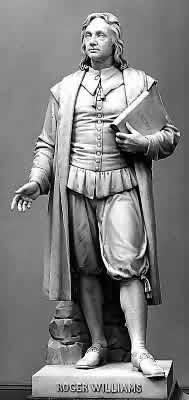 About two years before the Tefft boys and the Barber family departed for America, a man named Roger Williams had also made the journey. Back in England,
Williams was a priest in the Church of England, but he had always been interested in the Puritan movement. As such, he was warmly welcomed into the New
World by Massachusetts governor John Winthrop, and was almost immediately invited to replace Boston’s pastor, who was returning to England.
About two years before the Tefft boys and the Barber family departed for America, a man named Roger Williams had also made the journey. Back in England,
Williams was a priest in the Church of England, but he had always been interested in the Puritan movement. As such, he was warmly welcomed into the New
World by Massachusetts governor John Winthrop, and was almost immediately invited to replace Boston’s pastor, who was returning to England.
However, Williams declined this prestigious position because he determined that it was a “non-separated church”. Williams, like many other Puritans of
his day, believed they must completely separate themselves from the corrupt Church of England.
So instead, Williams became a philosophizer who asserted to anyone who would listen that the court magistrate must not be allowed to punish any sort
of "breach of the first table [of the Ten Commandments]," such as idolatry, Sabbath-breaking, false worship, and blasphemy. He also promoted
"Soul-Liberty", the ideal that every individual should be free to follow his own convictions in religious matters. Roger Williams proclaimed
to a growing audience in Boston that civil and religious laws were separate, and that governments could only be concerned with the civil matters.
Thus, through his early teaching and writing, Roger Williams laid the groundwork for the American Constitution’s concept of what he first called
"the wall of separation" between church and state. His concept of personal religious freedom is one of the foundations for the religion
clauses of the First Amendment to the United States Constitution.
Roger Williams was soon invited to become assistant pastor at nearby Salem, but several Boston leaders appealed to the Massachusetts Bay Colony
governor, and Williams was blocked from taking that position. He was then asked by the Plymouth Colony (a re-creation of part of the colony
is pictured below) to teach there, and he accepted.
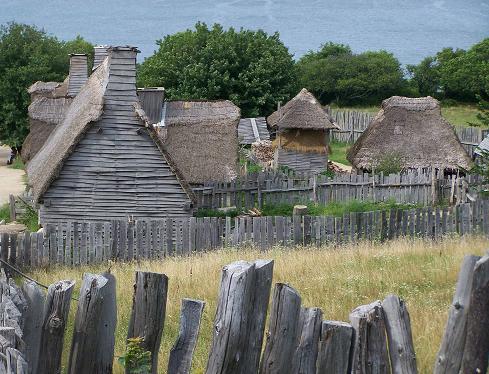 The Pilgrims at Plymouth Colony were receptive to his separatist viewpoints, and he remained there for about two years. Governor
Bradford of Plymouth Colony remarked that during this period "his teachings were well approved." However, toward the end of his stay, many
of the Plymouth Colony members were becoming frustrated that Williams was using sermons to promote his own personal ideas, particularly those
concerning his attitudes of cooperation and fairness toward the American Indians. So, in the summer of 1633, Williams went back to Salem
where he became the Pastor's “unofficial assistant”.
The Pilgrims at Plymouth Colony were receptive to his separatist viewpoints, and he remained there for about two years. Governor
Bradford of Plymouth Colony remarked that during this period "his teachings were well approved." However, toward the end of his stay, many
of the Plymouth Colony members were becoming frustrated that Williams was using sermons to promote his own personal ideas, particularly those
concerning his attitudes of cooperation and fairness toward the American Indians. So, in the summer of 1633, Williams went back to Salem
where he became the Pastor's “unofficial assistant”.
The 1633 ship carrying the Teffts and Barbers all arrived in this immediate area, probably very near this moment in time. They would have certainly
heard talk of Roger Williams. They would have also understood from the beginning that to live in this colony peaceably, they must now live
and believe as the Puritans lived and believed. Puritan law was strict and unbending, as Roger Williams would soon find out.
Within a year, the Massachusetts authorities had exiled him by law from Salem for spreading "diverse, new, and dangerous opinions" that questioned
the Church. In 1635 they fired him and banished him from the Massachusetts Bay Colonies forever!
Anne Hutchinson
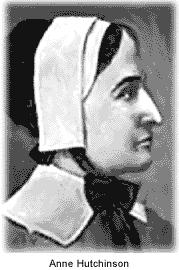 The exact manner in which John and William Tefft arrived in New England is cloudy, but they likely arrived on the Griffin or on another ship that came into the
Massachusetts Bay colony at about the same time. Governor John Winthrop's journal dated 18 Sep 1634 states, "The Griffin and another ship now arriving
with about 200 passengers." Anne Hutchinson was on board, but save for a few others, the names of the 200 passengers on the Griffin is
unknown. But it is certain that a large number of the passengers on the Griffin eventually settled in Rhode Island after being expelled from
Boston with the Anne Hutchinson family.
The exact manner in which John and William Tefft arrived in New England is cloudy, but they likely arrived on the Griffin or on another ship that came into the
Massachusetts Bay colony at about the same time. Governor John Winthrop's journal dated 18 Sep 1634 states, "The Griffin and another ship now arriving
with about 200 passengers." Anne Hutchinson was on board, but save for a few others, the names of the 200 passengers on the Griffin is
unknown. But it is certain that a large number of the passengers on the Griffin eventually settled in Rhode Island after being expelled from
Boston with the Anne Hutchinson family.
Like John and William Tefft, Anne Hutchinson came to America from Lincolnshire, England. She was initially highly regarded in the community because of her
intelligence and caring nature, but later ran into difficulty because of her religious views and outspoken nature.
Deeply fascinated by intricate theological issues, Hutchinson began to hold weekly discussion groups in her home following Sunday services. Attendance at these
meetings grew rapidly. After establishing her skill as the discussion leader, Hutchinson revealed her support of the efficacy of faith alone (the covenant of
grace) as the key to salvation, as opposed to the standard Puritan emphasis on good works (the covenant of works). She also expressed her belief that God
revealed himself to individuals without the aid of clergy.
Governor Winthrop was leery of Hutchinson’s views and cautioned that women could do irreparable damage to their brains by pondering deep theological
matters — a view not uncommon for the day. Winthrop and others brought her to trial before the General Court in 1637, where she
was found guilty, and like Roger Williams, she was banished from the Massachussetts Bay Colonies forever!
Rhode Island
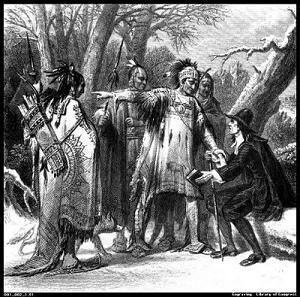 Chief Canonicus of the Narragansett Indians in Rhode Island was a firm friend of English settlers, and he gave a large tract of land to Roger Williams in 1636.
Chief Canonicus of the Narragansett Indians in Rhode Island was a firm friend of English settlers, and he gave a large tract of land to Roger Williams in 1636.
Williams then established a temporary trading post and settlement in Rhode Island at the intersection of two major Native American thoroughfares. His
settlement was based on a covenant of the people based on a principle of equality. Obedience to the majority was promised by all, but "only in civil things."
The colony was named Providence Plantation, due to Williams’ belief that God had sustained him and his followers and brought them to this place. When he later
acquired other islands in the Narragansett Bay, he named them after other virtues: Patience Island, Prudence Island and Hope Island.
Some of the followers of the also-banished Anne Hutchinson visited Williams at Providence in 1637 to seek his guidance in moving away from Massachusetts. He
advised the Hutchinson group to purchase land on nearby Aquidneck Island from the Narragansett Indians. They did purchase land and settled in
Pocasset, now Portsmouth, Rhode Island.
It is altogether possible that John Tefft and/or Mary Barber were Anne Hutchinson supporters and followers back in Boston. Hutchinson,
Barber and Tefft are all known to have relocated from Boston to Portsmouth, Rhode Island between 1637 and 1640.
Or, perhaps John Tefft and Mary Barber were just being opportunistic, and felt this was their best chance to escape the religious rigors of
Puritanical life in Boston. As you read on, you'll find that John Tefft, like many of his descendents, was indeed an opportunist and
one rugged individual.
Most of the settlers who left Massachussetts for Rhode Island were of the type of founders, antinomians and
malcontents -- men who could not endure the rigors of Puritan theology, law, and custom. In fact, their spirit of freedom was extreme,
and it went wild. They could not agree among themselves, and for many years Rhode Island was the most turbulent of all the New England colonies.
While his personal motivation may be unclear, it is certain that John Tefft moved from Boston to Portsmouth (Kingstown), Rhode Island, and there married the
above mentioned Mary Barber in about 1640. Together they had two sons (Samuel b1644 and Joshua b1646) and two daughters (Mary b1642
and Tabitha b1652). All of their children were recorded as having been born in Portsmouth, Rhode Island. It’s likely, though, that John and his wife
lived for a period of years on the western side of Narragansett Bay in "Narragansett Country", a few miles west of Portsmouth. It’s also
likely that John Tefft and his family peacefully co-existed with the Narragansett Indians during these years as evidenced by documents proving that
John and his two sons were all able to speak in the native Narragansett tongue.
American Roots
In 1655, John Tefft was made a freeman, a civil and political status which insured one a share in the common land. John's brother William remained back in
Boston where he became a tailor. William bought a house there in 1638, married and had one daughter, Lydia. William Tefft was admitted to the Church in 1640,
and he was declared a freeman in 1648. In 1646, he made a will, and in it he specifically bequeathed his youngest steer calf to the oldest child of his brother
John Tefft. William Tefft died in 1648, probably only in his early fifties.
Samuel Tefft, John's oldest son and your ancestor, married Elizabeth Jenckes in 1658. Elizabeth’s brother, Joseph Jenckes, would later become
deputy governor of Rhode Island, and Elizabeth’s grandfather, Joseph Jenckes had earlier cut the die for the first ever American made coin in 1652,
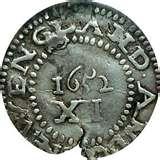 the “pine tree shilling”, pictured here.
the “pine tree shilling”, pictured here.
In 1658, five Boston settlers bought 28,000 acres of land in Rhode Island from Narragansett Chief Sachems Quassachquansh, Kachanaquant and Quequaquenuet, for the
reported price of 16 pounds sterling, a British officer's red coat, and an unnamed number of other goods. Our ancestor John Tefft served
as an interpreter for these five buyers as they negotiated the sales contract with the Narragansett chiefs!
This purchase was hereinafter referred to as the Pettaquamscutt Purchase. About three years later, in 1661, a second tract of land
totaling 36,000 acres were added to the original purchase and two new buyers also received large shares of land. The names of all seven
buyers were Samuel Wilbor, John Hull, John Porter, Samuel Wilson, Thomas Mumford, William Brenton and Benedict Arnold (the great-grandfather of the
Benedict Arnold that was convicted of treason during the American Revolution). John Tefft served as a witness to this second Pettaquamscutt
Purchase, and later in 1661 he purchased 500 acres of this land from these men for himself and his family.
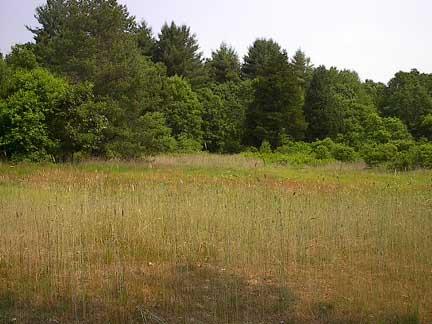 Situated along southern Rhode Island’s coastal plain, the land that John Tefft purchased in 1661 enjoyed some of the mildest weather in all of New
England. The presence of two natural springs provided an ample water supply. Glacial deposits provided the raw material for the
many stone walls that cover the landscape marking the remains of several small arable fields, orchards and pastures. At the time of European
contact in the mid-17th century, it is likely that the lowland was burnt-over cropland utilized by the Narragansett people, while the uplands contained
stands of mature softwood forests.
Situated along southern Rhode Island’s coastal plain, the land that John Tefft purchased in 1661 enjoyed some of the mildest weather in all of New
England. The presence of two natural springs provided an ample water supply. Glacial deposits provided the raw material for the
many stone walls that cover the landscape marking the remains of several small arable fields, orchards and pastures. At the time of European
contact in the mid-17th century, it is likely that the lowland was burnt-over cropland utilized by the Narragansett people, while the uplands contained
stands of mature softwood forests.
From John Tefft’s 1674 will, we learn that he also owned a 20 acre homestead along the Pettaquamscutt River in the Tower Hill area of the Pettaquamscutt
Purchase. John Tefft and his two sons, Joshua and Samuel Tefft, settled the 500 acre property and began to raise livestock, cattle in particular, in the
mid-1660s. The old homestead site was situated near the center of the property. Nearby was a natural protective peninsula in the Genessee Swamp called Tobey’s
Neck. Along with its natural springs and fertile ground, the site was ideal for agricultural pursuits. This large parcel of land remained in the Tefft family
as a working farm until 1909. About 28 acres of the farm have been preserved and today this land is called “Tefft Historical Park.”
By all accounts, from about 1661 to 1675 the Tefft family lived peacefully on this land with their Narragansett neighbors. But events were soon to turn
against them in a most horrific and gruesome way.
King Philip's War 1675-1676
Across the Narragansett Bay from the Tefft farm, on the eastern side, lived another tribe of Native Americans called the Wampanoag. Their chief
was Massasoit, who made a treaty of friendship with the colonists, which he faithfully observed until his death. But when Massasoit died, he was succeeded by
his son, known to the English as “King Philip”. The encroachment of the colonists upon Indian lands led King Philip, already the head of 500 warriors of his own
tribe, to form a coalition of all the Indians from the Merrimac River to the Thames (including the Narragansetts) for the purpose of driving out or exterminating
the whites.
The war, named “King Philip’s War”, began in 1675 and lasted two years. King Philip’s War was the most destructive conflict in the history of New England.
All colonial structures south of Warwick were completely destroyed. King Philip and all the other leading Indian chiefs were killed. The Wampanoag and
Narragansett tribes were practically exterminated, and any Indian survivors fled to safer interior lands. Many of the Indians who surrendered were soon
sold into slavery, and quite suddenly thirty years of peaceful co-existence between the settlers of the region and the Narragansett people was over. On November 2,
1675, Plymouth Colony governor Josiah Winslow led a combined force of colonial militia against the Narragansett tribe. The
Narragansett had not been directly involved in the war, but they had sheltered many of the Wampanoag women and children. Several of their
warriors were reported in several Indian raiding parties. Many of the colonists distrusted the tribe and didn't understand the various alliances.
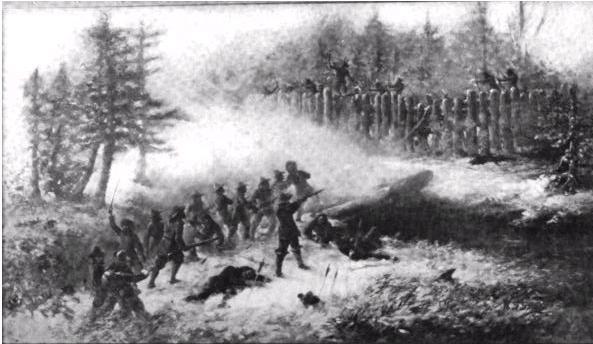 As the colonial forces went through Rhode Island, they found and burned several Indian towns which had been abandoned by the
Narragansett, who had retreated to a massive fort in a swamp. Led by an Indian guide, on December 16, 1675, the colonial force found the
Narragansett fort near present-day South Kingstown and attacked it, only about two miles from the Tefft farm! A combined force of Plymouth, Massachusetts, and
Connecticut militia numbering about 1,000 men, including about 150 Pequots and Mohicans, attacked the fort. The battle that followed is known as the Great Swamp
Fight. It is believed that the militia killed about 300 Narragansett. The militia burned the 5-acre fort
and destroyed the tribe's winter stores. Many of the warriors and their families escaped into the frozen swamp. The colonists lost many of their officers
in this assault. About 70 of their men were killed and nearly 150 more wounded.
As the colonial forces went through Rhode Island, they found and burned several Indian towns which had been abandoned by the
Narragansett, who had retreated to a massive fort in a swamp. Led by an Indian guide, on December 16, 1675, the colonial force found the
Narragansett fort near present-day South Kingstown and attacked it, only about two miles from the Tefft farm! A combined force of Plymouth, Massachusetts, and
Connecticut militia numbering about 1,000 men, including about 150 Pequots and Mohicans, attacked the fort. The battle that followed is known as the Great Swamp
Fight. It is believed that the militia killed about 300 Narragansett. The militia burned the 5-acre fort
and destroyed the tribe's winter stores. Many of the warriors and their families escaped into the frozen swamp. The colonists lost many of their officers
in this assault. About 70 of their men were killed and nearly 150 more wounded.
While the rest of the Tefft family had earlier sought safety on Aquidneck Island, Joshua remained behind at the family farm to care for the cattle.
The War's Aftermath
Immediately after the Great Swamp Fight, Captain Oliver of Massachusetts reported that Joshua Tefft had "shot 20 times at us in the swamp." An
Indian spy also reported that Joshua "did them good service & kild & woonded 5 or 6 English in that fight & before they wold trust him hee had kild a miller
an English man at Narragansett and brought his scalpe to them." To further substantiate these claims, an Indian woman taken captive by the English
of the United Colonies reported that Joshua had been their "encourager and conductor".
Joshua Tefft, John’s oldest son and Samuel’s brother, was arrested and accused of high treason. Joshua claimed in court that he had been captured by the Indians
and was held prisoner for 27 days and put to work as a slave for a period of time during the war. Joshua claimed that "Himselfe had no Arms at all" at his
interrogation recorded bythe aforementioned Roger Williams in Providence. But Joshua was nonetheless convicted, and was subsequently extradited to Wickford
into the custody of General Josiah Winslow, Governor of Plymouth, and Richard Smith on January 16, 1676.
Two days later, at Smith's garrison, Joshua was executed for high treason, the only Englishman to suffer such a fate in all New England history. Major William
Bradford of Plymouth wrote: "The Englishman that was taken had his doom yesterday, to be hanged and quartered; which was done effectually."
As set out in the Incorporation of Providence Plantations in 1647, the following provision details the execution process, presumed to have been used against
Joshua Tefft at Smith's Castle. "For high treason, if a man, he being accused by two lawful witnesses or accusers, shall be drawn upon a hurdell unto the place
of execution, and there shall be hanged by the neck, cut down alive, his entrails and privie members cut from him and burned in his view; then shall his head be
cut off and his body quartered; his lands and his goods all forfeited."
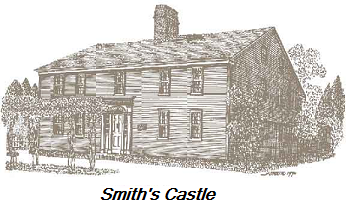
Frequently, a victim's body or head would be publicly displayed as a warning to others. In a letter referring to his execution, Joshua Tefft was described as "a
sad wretch who had never heard a sermon but once these past 15 years", and that "there would not be an abundance of tears over his death." Some sources seem to
ponder the real reason for his execution, for firing on the British, or for being a heathen. Joshua Tefft was survived by one son, Peter, who was just three years
old. His wife, Sarah had died in 1672 during this childbirth.
When hostilities ceased, the colonial government of Rhode Island took an almost friendly posture towards Peter Tefft and the Tefft family. Samuel Tefft, Joshua's
brother and your ancestor, was legally declared a freeman of the colony in 1677, and was granted custody of Peter, a nine year old boy in 1681. Peter was clearly
recognized in the guardianship order as a landowner apparently having right to all the possessions of his father, despite his father’s execution as a felon by
Puritan authorities, and even though colonial law required a convicted traitor's lands and goods to be forfeited.
The elder John Tefft was devastated by his son’s execution, and he died just a few years afterward in 1679. Here is a transcript of his will. In it he mentions his
wife Mary, his sons Samuel and Joshua, his daughter Tabitha and his son-in-law Samuel Wilson.
John Tefft's Will
RI Land & Public Notary 1:246
The last Will and Testament of John Tift on the Thirtith day of November in the yeare of Our Lord One Thousand Six hundred Seventy & four bein in sound minde & perfect
memory the Lord God be praised in the first place I commit my soule unto God my Saviour and my body unto a decent burial, And as for what worldy Goods I have I order
and dispose of as followeth, I freely give and bequeath unto my sonn in law Samuell Wilson my now dwelling house in pettacomscutt together with my house lott consisting
of Twenty Acres to him his heires-Administrators or assignes from the day of the makeinge of this my last Will & forever To have and to hold to his the said Samuell Wilson
or assignes owne use and behoofe together with all yards gardens Clossures out fences or outhouse or houseings with all other previledges or appurtenances thereunto in
any wise belonginge, Alsoe my will is that my wife Mary Tift shall have all my Cattell or Chattellsof what kinde soe ever, which is to say two Oxen two Cowes, two yearling
steers Eight of Swine kind, and one Ewe & a lamb--together with all other Moveables of household Stuff, My will is that my Sonn Samuell Tift shall have two shillings and
My Sonn Joshua Tift shall have one shilling, and my daughter Tabiatha Tift one Shilling, as alsoe one Iron pott which my daughter Tabiatha shall have after my wifes
decease My will is that my sonn in law Samuell Wilson and my son Joshua Tift Shall equally pay my debts which is to the sum of one pound three shillings I doe alsoe
by these owne this my true last and perfect will and doe utterly by these presents dissowne any other will that have or ever hereafter shall be made by me the said
John Tift unto which Will I binde my heirs by my hand and seale the day & yeare above-Mentioned ~
Witness hereunto William Hiffernan John T Tift
Alexander ~ King his marke his mark
I am Satisfyed for my thirds as Wit my hand Mary V Tift Oct: ye 19th 1679 her marke
Tabitha S Gardner her marke
James Donallsone his marke LN
The above written is A True Copy of the Original Entered per: John Sanford Recorder
In the decade following King Philip's War, the Tefft farmland remained largely abandoned due to Rhode Island’s recurrent boundary conflict with the colony of Connecticut.
However, Samuel Tefft returned to re-occupy and work his father’s land in the mid-1680s, being taxed nine shillings by the Andros administration in 1687.
Samuel and Elizabeth Tefft had 3 sons: John (b1676), Samuel and Joseph and 7 daughters (Sarah, Elizabeth, Esther, Mary, Tabitha, Mercy and Susannah). The eldest son John
(your ancestor) was born in South Kingstown and all the other children’s births were documented in Kingstown, Rhode Island. Sarah Tefft, one of Samuel and Elizabeth’s
daughters, is recorded as having been baptized in 1679 at the Sabbatarian Church in Newport, Rhode Island. The Sabbatarians of that time, rooted in the Baptist tradition,
focused their belief on a strict interpretation of resting and not working on the Sabbath day, which most likely occurred on Saturday.
Shannock Purchase
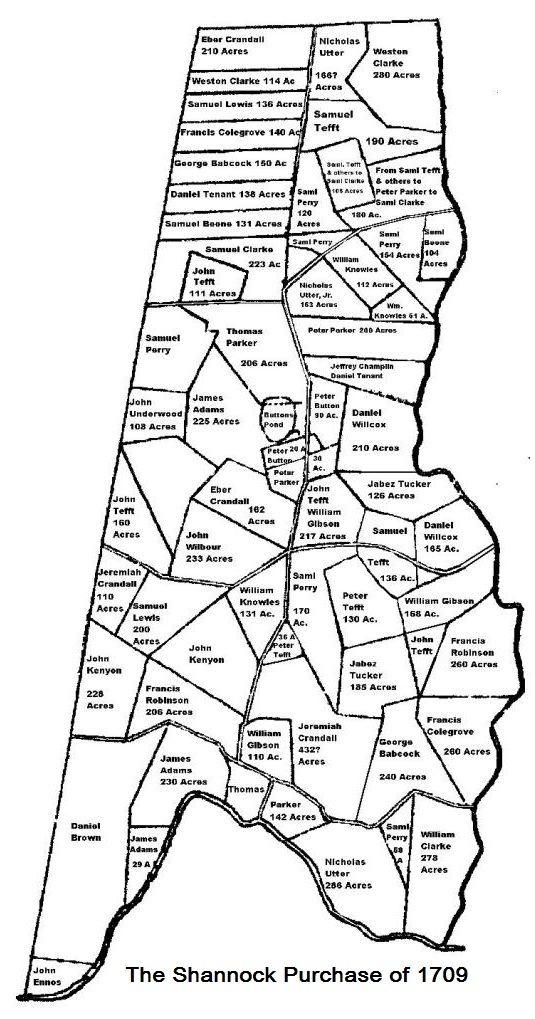 A few years after the turn of the century, the Tefft family petitioned the Rhode Island General Assembly regarding their interest in the now vacant Indian lands. In 1709,
three members of the Tefft family were among only twenty-six individuals granted exclusive right to take part in what was called the “Shannock Purchase”.
Samuel Tefft, his oldest son John, and Peter Tefft (Joshua’s orphaned son) purchased hundreds of acres of real estate in the second largest land grant to the citizens of
the Rhode Island colony. The property included much of the land that is present day Richmond, Rhode Island.
A few years after the turn of the century, the Tefft family petitioned the Rhode Island General Assembly regarding their interest in the now vacant Indian lands. In 1709,
three members of the Tefft family were among only twenty-six individuals granted exclusive right to take part in what was called the “Shannock Purchase”.
Samuel Tefft, his oldest son John, and Peter Tefft (Joshua’s orphaned son) purchased hundreds of acres of real estate in the second largest land grant to the citizens of
the Rhode Island colony. The property included much of the land that is present day Richmond, Rhode Island.
From the "History of the State of Rhode Island with Illustrations" printed in 1878: "Among the names of those interested in this early purchase, some of whom are numbered among the
early pioneers of Richmond, were the following; James Adams, Daniel Wilcox, Peter Parker, Daniel Tennant, Samuel Lewis, Nicholas Utter, Jr., William Gibson, William Clarke,
John Tefft, Thomas Utter, Eber Crandall, William Utter, John Eanos, Daniel Brown, Weston Clarke, George Babcock, George Foster, Joseph Brown, Nicholas Utter, Samuel Perry,
John Witter, Francis Colgrove, and Jeremiah Crandall.
And in "Richmond History" by Dr. Richard E. Wolke, Richmond Historical Preservation Commission, he writes "To stimulate settlement a commission of the General Assembly in 1709
sold certain vacant lands known as the ‘Shannock purchase’ to approximately 27 persons who then settled in the area. These early settlers included the Barbers, Browns, Clarkes
(Clarks), Hoxsies, Kenyons, Utters, Crandalls, Teffts and Perrys, names still common in the area."
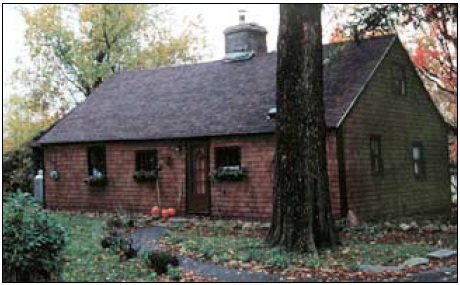 Over time a homestead, a complex network of stone walls, as well as an irrigation facility, animal facilities, and several outbuildings were built on the Tefft properties.
In about 1720, Samuel Tefft built another dwelling house (pictured here) in the northeast section of his property, and it not only survived, but was occupied until destroyed by
fire in December 2000!
Over time a homestead, a complex network of stone walls, as well as an irrigation facility, animal facilities, and several outbuildings were built on the Tefft properties.
In about 1720, Samuel Tefft built another dwelling house (pictured here) in the northeast section of his property, and it not only survived, but was occupied until destroyed by
fire in December 2000!
The Samuel Tefft house located at 70 Chestnut Hill Road, South Kingstown, Rhode Island, was one of the oldest in the town.
The Next Generations
Samuel Tefft died in 1725 at Kingstown, Rhode Island at the age of 81. His wife Elizabeth died 15 years later, also at Kingstown, at age 82. At the time of his death,
Samuel Tefft was quite wealthy. On top of large land-holdings, his personal inventory was valued at over 1,300 British pounds, and included wearing apparel, a sword, 11 cows,
5 oxen, 4 steers, 4 yearlings, 5 calves, 121 sheep, 5 mares, 3 horses, 15 swine, 2 linen wheels, 2 spinning wheels, worsted combs, 6 beds, 2 warming pans, cider, a cider mill,
22 geese, silver and 155 pounds in bonds. In Samuel Tefft’s will, he divided his property between his wife and sons:
To son John, 100 acres in South Kings Town, to son Sam, the south half of homestead, to son John and Sam, 135 acres in Westerly, to son Joseph, land in Shannock Purchase,
Westerly, to wife Elizabeth, the dwelling house, barn, orchard and the north half of homestead, and then John and Sam equally to maintain daughter Tabitha.
Samuel’s oldest son John inherited the northwest corner of the property. Samuel Tefft Jr. received the southern 250 acres. Upon the death of their mother Elizabeth in 1740,
Samuel Jr. bought out his brother John’s share of her land, leaving Samuel Jr. with total of 375 acres, or 3/4 of his grandfather’s original 500 acres. The 1730 Rhode Island
census reveals that Elizabeth and her two sons kept four Indians in their households, two of whom took on the Tefft name, Robin and Joshua.
Here’s a description of early Richmond Township, Rhode Island, again from “The History of the State of Rhode Island”:
Its average length from north to south, is about seven miles, its average breadth, from east to west, about six miles, comprising an area of about
forty-two square miles. The soil is of a gravelly loam, while the surface of the land is interspersed with a variety of rolling uplands and level plains. The forests furnish
some valuable timber, with a large supply for wood, while the agricultural products consist chiefly of hay, corn, oats, some rye, potatoes, butter, cheese, and some others.
The town is well watered by the Wood and Pawcatuck rivers. The Pawcatuck has several streams emptying into it, which have their source in different parts of the town,
furnishing ample facilities for the watering of this section.
By 1730, your ancestor John Tefft, son of Samuel Tefft was 54 years old and had 12 children of his own. His wife was Joanna (Sprague) Tefft and the children’s names were John,
Joanna, Samuel, Mary, Mercy, Joseph, Ann, Mehetable, James, Nathan, Tabitha and Sarah. Their second son Samuel was born in 1703, and he is your ancestor. Under John Tefft and
then his sons, the farm business prospered, with considerable income generated from sheep farming. Their ownership of cloth-making devices (spinning wheels, looms and brushes)
indicates that
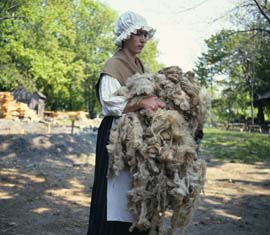 the family also was involved in the production of cloth and clothing, at least for their own use. In addition to tending to their cash crops and their own clothing needs, the
Teffts likely prepared an extensive garden each year. Shrubs, flowers, vegetables, fruits and herbs all grew happily together in colonial days. Plants were important not only
for their beauty but also for their dietary, domestic, cosmetic, and medicinal uses.
the family also was involved in the production of cloth and clothing, at least for their own use. In addition to tending to their cash crops and their own clothing needs, the
Teffts likely prepared an extensive garden each year. Shrubs, flowers, vegetables, fruits and herbs all grew happily together in colonial days. Plants were important not only
for their beauty but also for their dietary, domestic, cosmetic, and medicinal uses.
So far we've talked about the first John Tefft, his son Samuel Tefft and then John Tefft the son of Samuel. And you've read that this last John Tefft had a son named, you guessed
it, Samuel. Young Samuel Tefft, son of the second John Tefft, now in his 20's married Mercy Barber in 1727, and from 1728 to 1746 this couple bore 8 more Tefft children! (Ezekiel,
Oliver, Alexander, Abigail, Thankful, Mary, Mercy, and Sophia). From this large family, their oldest son Ezekiel Tefft, born in 1728, is your direct ancestor.
And so we begin the next family chapter as we continue from John, Samuel, John and Samuel to an entirely different name pattern.
Ezekiel * Ezekiel * Ezekiel
Ezekiel Tefft, born in 1728, lived through the American Revolutionary War. This first Ezekiel Tefft was about 48 years old when America declared its independence from England
in 1776, and his son Ezekiel, Jr. was about 16. They lived on the same property passed down through the Tefft family in Rhode Island from generation-to-generation.
He was the oldest son of Samuel Tefft and Mercy Barber Tefft. By his first wife Patience Potter, he had two children - Hezekiah and Marcy. By his second wife Eunice, he also had
two children - Samuel in 1764 and Ezekiel, Jr. in 1766. Ezekiel Tefft Jr. also had a son named Ezekiel and that story will come later. For now, we'll stay with the first
two Ezekiels.
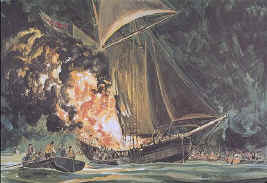 In the years before the revolution, Rhode Island, with its active shipping industry had been adversely impacted by British regulatory efforts following the French and
Indian War in the 1750's. Like other New Englanders, the Rhode Islanders had resorted to smuggling, which they conducted with much ingenuity. British officials in Rhode Island
wanted to increase their control over trade - legitimate trade as well as smuggling - in order to increase their revenue from the small colony. In 1772, the British customs ship
Gaspee ran aground while chasing a smuggler in Narragansett Bay. The stranded ship was boarded and burned by the colonists, clearly one of the most
provocative acts of the period. The identities of the colonists who took part were well-known but noone was ever convicted due to sympathetic local courts. The destroyed British
In the years before the revolution, Rhode Island, with its active shipping industry had been adversely impacted by British regulatory efforts following the French and
Indian War in the 1750's. Like other New Englanders, the Rhode Islanders had resorted to smuggling, which they conducted with much ingenuity. British officials in Rhode Island
wanted to increase their control over trade - legitimate trade as well as smuggling - in order to increase their revenue from the small colony. In 1772, the British customs ship
Gaspee ran aground while chasing a smuggler in Narragansett Bay. The stranded ship was boarded and burned by the colonists, clearly one of the most
provocative acts of the period. The identities of the colonists who took part were well-known but noone was ever convicted due to sympathetic local courts. The destroyed British
 vessel's location at the time of this incident was very close to Ezekiel's farm.
vessel's location at the time of this incident was very close to Ezekiel's farm.
In 1774, Rhode Island became the first colony to outlaw the slave trade. There is no evidence that any Tefft family member ever owned slaves or participated in the slave trade
in any way.
On May 4, 1776 Rhode Island was the first of the thirteen colonies to renounce its allegiance to the British Crown. And although little fighting occurred during the American
Revolution on Rhode Island soil, "the spirit of patriotism burned in the hearts of these revolutionary patriots, and in the promptness with which they met every demand made upon
them. They ever displayed a willingness to be taxed for the support of the cause in which they were engaged, and their ranks were filled with young men, and with many even
past the middle turn of life, and they never faltered in the hour of trial, or shrank from their responsibilities when duty called. They bade farewell to home, kindred, and
friends, and whether upon the tented field, or amid the din and smoke of battle, they were ever found at the post of duty, ready to do or die. They endured many long and weary
marches through blinding sleet or drifting snows, and their pursuing enemy often tracked their retreating columns by the blood that flowed from shoeless feet. Mothers bade farewell
to husband and son; daughters impressed the kiss of sisterly affection upon the brow of brothers, and returned the affectionate grasp of lover with tearless eye, as they bade them
God-speed, and sent them forth to stand in the gap of their country's perils. These records but evidence the spirit of patriotism and self-sacrificing devotion of these early
pioneers in the exigencies of the war for American freedom." (excerpt from History of Richmond)
In Richmond, Rhode Island town meetings were held in September 1776 and a vote was passed:
'That the soldiers ordered to be raised in this town by the committee appointed to act during the recess of the General Assembly, have their wages advanced to three shillings
per day, including what is paid them by the government, which shall enlist into the service.' Again voted, 'That captains of the companies in this town be and are hereby
directed to call more placed on the 19th instant, in order to raise the above mentioned troops.' Voted again, on the 20th of September, 'That Major Richard Bailey and Samuel
Clarke be appointed a committee to receive of William Tefft, Esq., twenty one guns, bayonets and cartouch boxes, and deliver them to the soldiers raised in this town,
and that the same be branded with the letter R before delivery, and that also they be directed to receive of the said William Tefft the remained of the guns &c when
finished, giving their receipts for the same, and that said committee furnish the ensign, and each soldier with a blanket and knapsack; and that every soldier furnishing
himself with a blanket and knapsack shall be allowed six shillings therefor.'
The second Ezekiel Tefft was born in 1760 Rhode Island and was married to Amy Wilcox in 1785. This couple reared six children – Hulda, William, Stephen, Nathan, the third Ezekiel
(born 1799) and Rowland. Three of these brothers erected and operated a cotton mill in a small community then known as “Brand’s Iron Works” (originally named after the local iron
foundry, changed its name to Wyoming in 1855). "…in 1814, a company was organized for the erection of a cotton factory. On June 1, in the above-named year, Ezekiel Tefft, Samuel
Tefft, Nathan Lillibridge, Stephen Tefft, and Nathan Tefft, entered into a co-partnership for the establishment of a cotton manufactory, under the firm-name and style of The
Brothers' Cotton Manufacturing Company. They completed the building, furnished it with appropriate machinery, and commenced the manufacture of cotton-yarn." The Ezekiel Tefft
mentioned in this article in “The History of the State of Rhode Island” would have almost certainly been the third Ezekiel (then 15 years old) and his brothers Nathan and Stephen.
Perhaps the Samuel Tefft mentioned was a cousin, and Nathan Lillibridge was a brother-in-law. The article continues to explain that the cotton factory came into the possession of
new owners before it eventually burned to the ground in 1862.
Another more exciting account of the early Tefft enterprise was found in an article written for the
Richmond Historical Society: "Around 1814 the three Tefft Brothers built a mill where the Dow Mill stood by the cement bridge. It was in operation for nearly one hundred and fifty
years. The power used was a wooden undershot reast wheel. The iron wheel, like the iron horse, had not been invented. Early one morning, in the month of May, as the operatives had
begun their work in the mill, they were greatly surprised to see the machinery come to a standstill. Going to the wheel-pit to learn the cause, they were more than shocked to see a
dead man's head and body wedged under the wheel. With difficulty the body was removed in a mangled condition and later identified as a traveling tinker who had been seen in the
area a few times, stopping with a family of not too good repute who resided in the little old house then standing on the site now occupied by the residence of the late Hon. John
L. Kenyon. (By the bridge across from the mill)." Wyoming developed into an industrial and commercial center around 1815, which was about the time the New London Turnpike was
opened. Crime of any sort was then almost unknown and you can imagine the excitement in the area to have a murder take place. It was the most talked about affair for months.
In 1815, this third Ezekiel A. Tefft married Mercy Wilbur. They had one daughter named Hulda (we’ll hear about her again) and four boys: William V.B., Gardner Rowland (your ancestor),
Lorin Palmer and another boy whose name is uncertain.
Portions of the Tefft property in Rhode Island continued to be parceled out as older family members passed on and new sons and grandsons came of age. The first Ezekiel likely
lived in the Tefft household from birth to death. The second and third Ezekiels were born in Rhode Island but would eventually migrate to New York. The third Ezekiel moved to
New York State for a few years and then finally to Ohio, where the ancestral line continued for many more generations.
Most of what we know about this first Ezekiel Tefft's
life comes from his will, recorded in 1811. Please notice the item in Ezekiel's will that references his son Ezekiel Jr., and his grandson Ezekiel (the 3rd son of Ezekiel Jr.). All
three Ezekiels are in your direct ancestral line. Ezekiel's will from 1811 also shows that he clearly favored the two sons he had from his second marriage. Hezekiah, from his first
marriage, was not given any land and only ten dollars from his personal estate.
July 22, 1811 PROBATE WILL FOR EZEKIEL TEFFT located at Town of Richmond /5 Richmond Townhouse Rd /Wyoming, RI 02898
In the Name of God Amen
I Ezekiel Tefft of Richmond in the country of Washington in the State of Rhode Island & Providence Plantations Yeoman Being of Sound and Perfect Memory and Considering the Uncertainty of this Mortal life,
and Returning sincere & hearty thanks to Almighty God for his many Blessings do make ordain and Publish this my Last Will and Testament. First I Recommend my Soul to God who gave it and my Body to be Decently
buried by my Executor hereafter Named, And as touching worthy Estate Wherewith it hath pleased God to Bless me With on this Life I, give dispose of & devise in manner and Form following.
IMPRIMIS. My Will is that my Executor herein after named Pay all my just Debts and Funeral Expenses.
ITEM. As my honored Father Samuel Tefft, Late, of Richmond Esqur Deceased in his Life Time by Deed gave his Homestead Farm to my Son Hezekiah Tefft, I Shall not Give the Said Hezekiah any Land.
ITEM. I Give and devise to my Son Ezekiel Tefft and to his Heirs and assigns forever my Homestead Farm whereon I now Live including the Lands I Purchased of Job Willcox of the Town Council of Richmond,
of Edward Perry, and about forty acres given me by Deed by my Father Which Farm and Lands are bounded as follows, beginning at the Northeast Corner of Land I Purchased of Said Town Council at a Button Wood Tree
by the Highway. Bounded North easterly and Easterly by Said Highway till it Comes to Land of John Foster Jr. Thence Southerly & Easterly by Said Fosters Land till it comes to Land of Edward Lillibridge thence
Bounded Southerly by Said Lillibridges Land till it comes to Land of Benjamin Card, thence Bounded Westerly and southerly by Said Cards Land till it comes to the Highway, thence bounded Northerly by Said
Highway to the first mentioned Bound Containing by Estimation One Hundred and Sixty Acres be the same moore or less With Two Dwelling Houses & other Buildings thereon Standing With the Appurtenances.
ITEM . I give and devise to my son Samuel Tefft to his Heirs and assigns forever the Easterly part of a Parcel of Land Lying in Richmond Aforesaid Given me by my father being Land he purchased of William Clarke
Which Easterly Part is Bounded as follows {VIZ} Beginning at a Rock with Stones on it By the Highway thence Running Northerly to Simeon Clarkes land Bounded Westerly by Land I Have by Deed Given to my son
Ezekiel Tefft and Thence Bounded Northerly by Said Clarkes Land Running East fourteen degrees North fifty chains to a White Ash Tree Standing in Beaver River marked W. C. ?L. S. C. Thence Bounded by ?Said?River
Down Stream till it Comes to Land now or Lately Called Benjamin ?Ja_? Land thence by Said Land to Beaver River thence Down Stream Bound ?_? By Said River till it Comes to the Highway thence by Said Highway to
the ?R_? First Mentioned With a Dwelling House thereon Standing With the appurture Containing by Estimation one Hundred Acres be the Same moore or Less A Carpenters Shop Built on Said Land by James Allen b
elongs to ?him? and __ is Reserved for him to Carry off at his Pleasure.
ITEM. I Give and Devise to my Said Son Samuel Tefft to his Heirs and assigns forever the Land I Received of the Town Council of Richmond in Exchange for the Highway mentioned in my last Devise, also all the Land
I own South of Said Highway Bounded Easterly by Beaver River Southerly Partly by Land of the Heirs of Daniel Dye and partly by Land now or Late belonging to John Dye till it comes to Said Highway.
ITEM. I Give and bequeath to my Daughter, Marcy Lillibridge, Wife of Gideon Lillibridge Sixty Dollars to be Paid her by my Executor out of my Personal Estate. Also I Give and Bequeath to the Said Gideon Lillibridge
a Note I hold against him for about Sixty Two Bushels of Corn With Interest.
ITEM. I Give and Bequeath to my Son Hezekiah Tefft Ten Dollars to be Paid Him out of my Personal Estate
ITEM. I Give and Bequeath to my Son Samuel Tefft my Desk and One Hundred Dollars in Like manner as the Preceding Bequest.
ITEM. I Give and Bequeath to my Grand Daughter Elisabeth Willcox, Wife of Benjamin Willcox Ten Dollars to be Paid in Like Manner.
ITEM. I Give and Bequeath to my Grand Daughter Judah Hall, Wife of Seneca Hall Ten Dollars to be Paid in Like Manner.
ITEM. I Give and Bequeath to my Grandson Samuel Lillibridge fifteen Dollars to be Paid him in Like Manner.
ITEM. I Give and Bequeath to my Grand Daughter Huldah Tefft Daughter of Ezekiel Tefft Jr. ten Dollars to be Paid her in Like manner also one Feather Bed & Bedding.
ITEM. I Give and Bequeath to my grandson Ezekiel Tefft 3rd Son of Ezekiel Tefft Jr. Twenty two Dollars to be Paid in Like Manner.
ITEM. I Give and bequeath to my Grandson Nathan Lillibridge ten Dollars to be Paid in Like Manner.
ITEM. I Give and Bequeath to my Said Grand Daughter Huldah Tefft a case of Drawers Made by William Bentley.
ITEM. I Give and Bequeath to my Said Daughter Marcy Lillibridge a Silver Tablespoon marked on the Back E T E (underneath those initals were these intials) M * T
ITEM. I Give and Bequeath to my son Ezekiel Tefft a Silver Table Spoon Marked on the Back
ITEM. I Give and Bequeath to my Son Ezekiel Tefft Jr. one Silver Table Spoon marked on the Back E T E (underneath those initials were these initials) E * E
ITEM. I Give and Bequeath to my Son Samuel Tefft one Silver Table Spoon marked on the Back E T E (underneath those initals were these initals) T * T
ITEM. I Give and Bequeath to my Beloved Wife Eunice a Silver Table Spoon marked on the Back E T E T * T also a Cow and all my Household Goods and Furniture not herein allready Disposed of
ITEM. All the Rest and Residue of my Personal Estate of What Name or Nature so ever after Payment of my Just Debts Funeral Expenses and the Legacies and Bequests herein before mentioned I Give and Bequeath to
my Two Sons Ezekiel Tefft Jr. and Samuel Tefft to be equally divided between them.
LASTLY. I nominate constitute and appoint my son Samuel Tefft my Executor of this my Last Will and Testament.
In Testimony Whereof I Here unto set my Hand & Seal the first Day of September in the year of our Lord one Thousand Eight Hundred and one and of Independence the Twenty Sixth
Signed Sealed Published & Declared (signature) Ezekiel Tefft {seal}